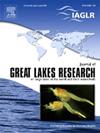尚普兰湖流域lampriides对非目标物种的急性毒性研究
IF 2.4
3区 环境科学与生态学
Q3 ENVIRONMENTAL SCIENCES
引用次数: 0
摘要
先前的研究评估了lampricide 4-硝基-3-(三氟甲基)苯酚(TFM)以及TFM与1%氯硝柳胺(TFM:1%Nic)的组合对劳伦森五大湖多种非目标物种的毒性。然而,尚普兰湖(纽约州和佛蒙特州)的毒性研究很少。我们对4种本地贻贝、6种鱼类和1种两栖动物进行了12小时的毒性测试。所有试验均包括暴露于侵入性海七鳃鳗(Petromyzon marinus)幼虫,并在控制海七鳃鳗幼虫所需的预测最低致死浓度范围内进行。在纯TFM毒性试验中,贻贝的NOEC、LOEC、LC25和LC50分别为现场测定lc99.9的1.33 ~ 2.12、1.71 ~ 2.66、1.75 ~ 3.05和2.03 ~ 4.84倍;在TFM:1%Nic毒性试验中,贻贝的NOEC、LOEC和LC50分别为1.36 ~ 1.70、1.68 ~ 2.03、1.86 ~ 2.10和2.35 ~ 2.68倍SLLC99.9。纯TFM毒性试验中NOEC、LOEC、LC25和LC50值分别为0.60 ~ 1.89、0.73 ~ 2.13、0.72 ~ 2.11和0.76 ~ 2.18 × SLLC99.9, TFM:1%Nic毒性试验中NOEC、LOEC和LC50值分别为0.64 ~ 2.48、0.85 ~ 3.10、0.74 ~ 3.05和0.78 ~ 3.16 × SLLC99.9。纯TFM毒性试验中,两栖动物NOEC、LOEC、LC25和LC50值分别为0.74 ~ 0.75、0.85 ~ 0.95、0.83 ~ 0.87和0.85 ~ 0.91 × SLLC99.9; TFM:1%Nic毒性试验中,NOEC、LOEC和LC50值分别为0.63 ~ 0.65、0.80 ~ 0.88、0.77 ~ 0.82和0.78 ~ 0.87 × SLLC99.9。一般而言,贻贝种类对TFM具有耐受性,鱼类的敏感性是可变的,两栖类对TFM和TFM:1%Nic敏感。本文章由计算机程序翻译,如有差异,请以英文原文为准。
Acute toxicity of lampricides to non-target species of concern in the Lake Champlain watershed
Previous research evaluated the toxicity of the lampricide 4-nitro-3-(trifluoromethyl)phenol (TFM) and the combination of TFM with 1 % niclosamide (TFM:1%Nic) to multiple non-target species in the Laurentian Great Lakes. However, few toxicity studies have been conducted for species of concern in Lake Champlain (NY and VT). We conducted 12-hour flow-through toxicity tests with 4 species of native mussels, 6 species of fish, and 1 amphibian species. All tests included exposure of invasive larval Petromyzon marinus (sea lamprey) and were conducted with concentrations that bracketed the predicted minimum lethal concentration required to control larval sea lamprey. Mussel species’ NOEC, LOEC, LC25, and LC50 values ranged from 1.33 to 2.12, 1.71–2.66, 1.75–3.05, and 2.03–4.84 times field determined LC99.9s for sea lamprey (×SLLC99.9) in TFM-only toxicity tests, and from 1.36 to 1.70, 1.68–2.03, 1.86–2.10, and 2.35–2.68 × SLLC99.9 for TFM:1%Nic toxicity tests, respectively. Fish species NOEC, LOEC, LC25, and LC50 values ranged from 0.60 to 1.89, 0.73–2.13, 0.72–2.11, and 0.76–2.18 × SLLC99.9 in TFM-only toxicity tests, and from 0.64 to 2.48, 0.85–3.10, 0.74–3.05, and 0.78–3.16 × SLLC99.9 for TFM:1%Nic toxicity tests, respectively. Amphibian species NOEC, LOEC, LC25, and LC50 values ranged from 0.74 to 0.75, 0.85–0.95, 0.83–0.87, and 0.85–0.91 × SLLC99.9 in TFM-only toxicity tests, and from 0.63 to 0.65, 0.80–0.88, 0.77–0.82, and 0.78–0.87 × SLLC99.9 for TFM:1%Nic toxicity tests, respectively. Generally, mussel species were tolerant, fish sensitivities were variable, and the amphibian species was sensitive to TFM and TFM:1%Nic.
求助全文
通过发布文献求助,成功后即可免费获取论文全文。
去求助
来源期刊

Journal of Great Lakes Research
生物-海洋与淡水生物学
CiteScore
5.10
自引率
13.60%
发文量
178
审稿时长
6 months
期刊介绍:
Published six times per year, the Journal of Great Lakes Research is multidisciplinary in its coverage, publishing manuscripts on a wide range of theoretical and applied topics in the natural science fields of biology, chemistry, physics, geology, as well as social sciences of the large lakes of the world and their watersheds. Large lakes generally are considered as those lakes which have a mean surface area of >500 km2 (see Herdendorf, C.E. 1982. Large lakes of the world. J. Great Lakes Res. 8:379-412, for examples), although smaller lakes may be considered, especially if they are very deep. We also welcome contributions on saline lakes and research on estuarine waters where the results have application to large lakes.
 求助内容:
求助内容: 应助结果提醒方式:
应助结果提醒方式:


